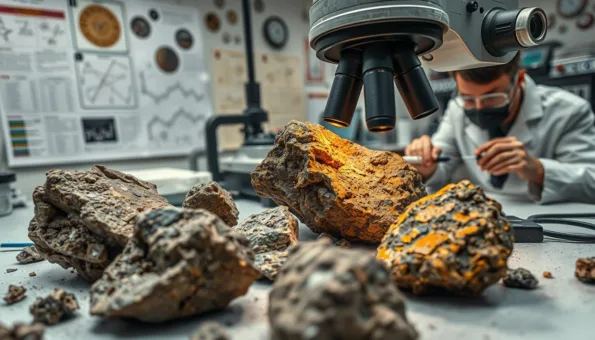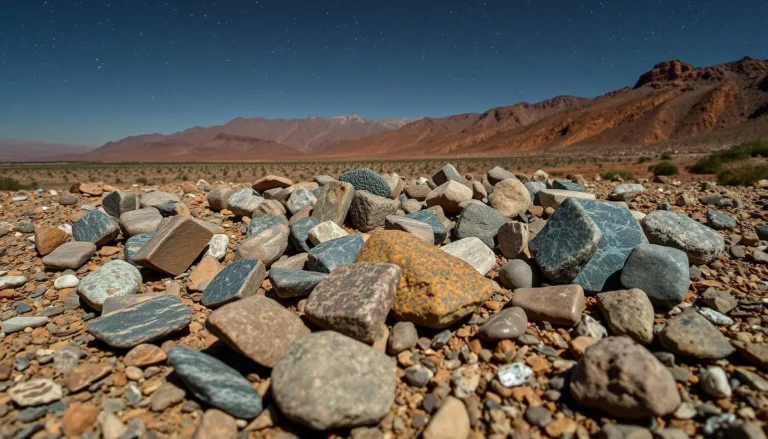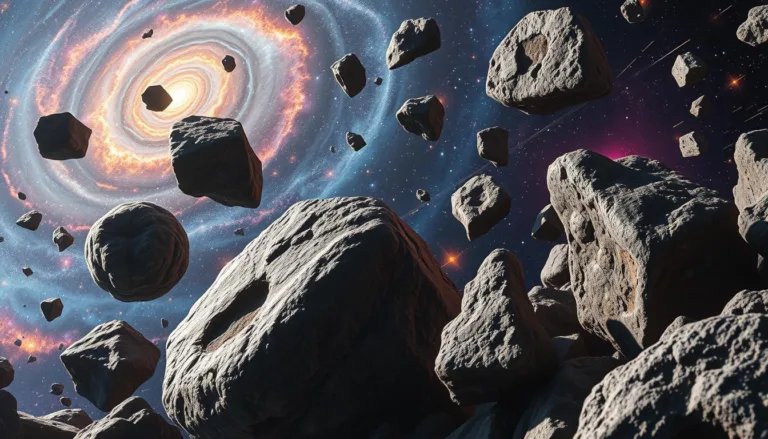Welcome to our journey into the world of meteorites! Ever found a rock and thought, *how do you tell if a rock is a meteorite?* Learning how to spot meteorites is key for space enthusiasts. We’ll cover the basics of finding out if a rock is from space. You’ll learn about the signs, how to check, and where to find more info.
Key Takeaways
- Identifying meteorites enhances our understanding of the universe.
- Look for unique characteristics to distinguish meteorites from regular rocks.
- Testing methods can confirm the authenticity of suspected meteorites.
- Involve experts to ensure accurate meteorite identification.
- Effective documentation is crucial when discovering meteorites.
Understanding Meteorites: A Brief Overview
Meteoroids, meteors, and meteorites can confuse many. Meteoroids are small space rocks. When they enter Earth’s atmosphere and light up, they become meteors. If they land, they are called meteorites. Studying meteorites helps us learn about space and the materials that fall to Earth.
What Are Meteorites?
Meteorites are pieces of space that make it to Earth. They tell us about the solar system’s start and planets’ origins. These objects range from tiny to huge, weighing tons. By studying them, scientists learn about space and planet formation.
Types of Meteorites
Meteorites are mainly two types: stony and metallic. Stony ones are mostly silicate minerals. Metallic ones are iron and nickel. Each type has its own features and subtypes, making them interesting to study.
| Type of Meteorite | Description | Notable Examples |
|---|---|---|
| Stony Meteorites | Primarily composed of silicate minerals. | Chondrites, Achondrites |
| Metallic Meteorites | Composed mainly of iron and nickel. | Iron Meteorites |
How Do You Tell If a Rock Is a Meteorite?
Figuring out if a rock is a meteorite involves knowing certain signs. These signs make meteorites stand out from regular rocks. We’ll look at common traits and use visual methods to improve our skills in identifying meteorites.
Common Characteristics to Look For
Several signs can show if a rock is a meteorite:
- Weight: Meteorites are usually heavier than rocks of the same size because they are denser.
- Color: They often have a dark outside and a lighter inside. Their surface might look fusion black or rusty brown.
- Texture: A clear texture can show chondrules, small, round particles from the early solar system.
- Melting Crust: A fusion crust, formed when entering the atmosphere, makes meteorites shiny and glassy.
- Sheen: Their unique sheen catches light differently than most earth rocks, hinting at their space origin.
Visual Identification Techniques
Using different visual methods can help a lot in identifying meteorites. Here are some tips:
- Magnification: A hand lens or microscope can show small details like chondrules or unique structures.
- Streak Testing: Rubbing the rock on a porcelain tile can show its streak color, which might be different from the rock itself if it’s a meteorite.
- Scratch Test: Checking hardness with minerals like quartz can help see if the rock matches known meteorite material.

By using these visual methods, identifying meteorites becomes more systematic and fun for space enthusiasts.
Meteorite Testing: Methods and Tools
When we test meteorites, the right tools and methods are key. They help us figure out if a rock is really from space. We often use the magnetism test and fusion crust analysis for this.
Magnetism Test: Is Your Rock Magnetic?
The magnetism test is simple but effective. Many meteorites have magnetic minerals. This makes them attract magnets.
To do this test, we just need a magnet. If the rock pulls towards the magnet, it might be a meteorite. But, not all meteorites are magnetic. So, this test is just one clue.
Fusion Crust Analysis
Fusion crust analysis is also crucial. This thin, glassy layer forms when a meteorite enters Earth’s atmosphere. By looking at the fusion crust’s texture and color, we can tell if a rock is from space.
A smooth, shiny fusion crust usually means it’s a meteorite. But, a rough surface might mean it’s from Earth. Using both tests helps us make more accurate guesses about a rock’s origin.
Meteorite Characteristics to Identify
Knowing the unique features of meteorites is key to identifying them. A big part of this is understanding the difference between chondrites and achondrites. These two types have different compositions and ways of forming, giving clues about where they came from.
Chondrites vs. Achondrites
Chondrites are the most common type of meteorite. They are made up of small, round particles called chondrules. These particles formed early in the solar system’s history. Chondrites also have a mix of silicates, metal, and sulfides, showing they are from the early days of the solar system.
Achondrites, on the other hand, don’t have these chondrules. They come from the melted and solidified parts of bigger bodies. Their minerals tell a story of melting and cooling, making them different from chondrites.
| Characteristic | Chondrites | Achondrites |
|---|---|---|
| Presence of Chondrules | Yes | No |
| Formation | Primitive solar system materials | Differentiated parent bodies |
| Common Elements | Silicates, metals, sulfides | Igneous minerals |
| Examples | Ordinary chondrites, carbonaceous chondrites | Hawaiian achondrites, Martian meteorites |
Streak Test: What Does It Reveal?
The streak test is a simple way to identify meteorites. It involves rubbing the meteorite on a porcelain plate to see the streak color. Each type of meteorite has a unique streak color, helping to tell them apart.
The streak test can also show if a meteorite has a lot of metal, like chondrites do. Knowing what the streak test shows helps us classify meteorites correctly.
Meteorite Verification: Getting Expert Help
Exploring meteorites is exciting, but knowing when to get expert help is key. Verifying a meteorite can show if a rock is truly from space or not. It helps us understand and value these cosmic wonders more.
When to Consult Meteorite Experts
There are signs that tell us when to seek meteorite experts. We should consider their help if:
- The rock looks unusual but doesn’t clearly show it’s a meteorite.
- We’re unsure if a rock is real or not.
- Our tests don’t give clear answers.
- The rock’s weight doesn’t match what we expect from meteorites.
- We want to know exactly what kind of meteorite it is for study or collection.
Online Resources for Meteorite Verification
There are many online tools to help with meteorite verification. Joining these communities can give us great advice and validation:
- Forums: Meteorite forums are great for asking questions and getting expert opinions.
- Databases: Online meteorite databases have lots of info on different meteorites, helping us identify them.
- Social Media Groups: Being part of meteorite groups on social media can get us quick advice and support.

Meteorite Hunting Techniques: Tips for Success
Meteorite hunting is an exciting adventure for those who love discovery. Knowing where to look and the best tools can boost your success.
Where to Look for Meteorites
Strategic planning is key to finding meteorites. The best spots include:
- Deserts: The dark meteorites stand out against the light sand.
- Agricultural fields: Tilled land makes meteorites easier to find.
- Areas near known meteorite falls: Researching recent falls can lead to finds.
Useful Tools for Meteorite Hunters
Having the right tools is crucial. Here are the essentials:
| Tool | Description |
|---|---|
| Magnetometer | Identifies metallic meteorites by detecting magnetic fields. |
| Field Guide | Helps tell meteorites apart from rocks. |
| Metal Detector | Searches for metallic meteorites with audio alerts. |
| GPS Device | Maps areas and marks useful spots. |
| Pick and Shovel | Needed for digging and sifting soil. |
Using effective techniques and the right tools makes hunting meteorites rewarding. Let’s explore this exciting journey together!
Meteorite Discovery: Documenting Your Find
Finding a meteorite is an exciting moment. It’s important to document it well. This helps keep the find’s details and value safe for science and future study.
How to Record Your Meteorite Find
To document your meteorite find right, follow these steps:
- Photography: Take clear photos from different sides. Good photos prove you found it.
- GPS Coordinates: Use a GPS to note the exact spot. This helps scientists later.
- Environmental Conditions: Write down the weather, ground, and nearby sights. This helps understand where it came from.
Reporting Your Find: Importance of Documentation
After documenting, report your find. Places like the Meteoritical Society accept reports. This is key for:
- Scientific Research: Sharing your find helps science grow.
- Value Assessment: Good documentation can make the meteorite more valuable.
- Historical Record: Your report adds to the history of meteorite finds.
Conclusion
We’ve explored the world of meteorites and learned how to tell them apart from regular rocks. We’ve talked about their special features, how to test them, and why keeping detailed records is important. This knowledge helps us appreciate the beauty and rarity of meteorites.
When we search for meteorites, the fun is in the discovery and learning along the way. It’s vital to get expert verification to make sure our finds are real. Keeping detailed records of our discoveries helps prove their authenticity and shares our adventures with others.
Meteorite hunting is a mix of adventure, science, and community. We invite everyone to join in, facing the challenges and enjoying the rewards of finding meteorites. Let’s keep exploring and learning about these amazing space rocks, deepening our understanding and love for the universe.







